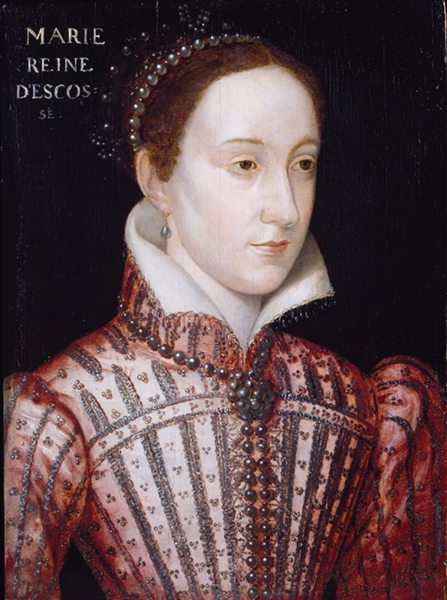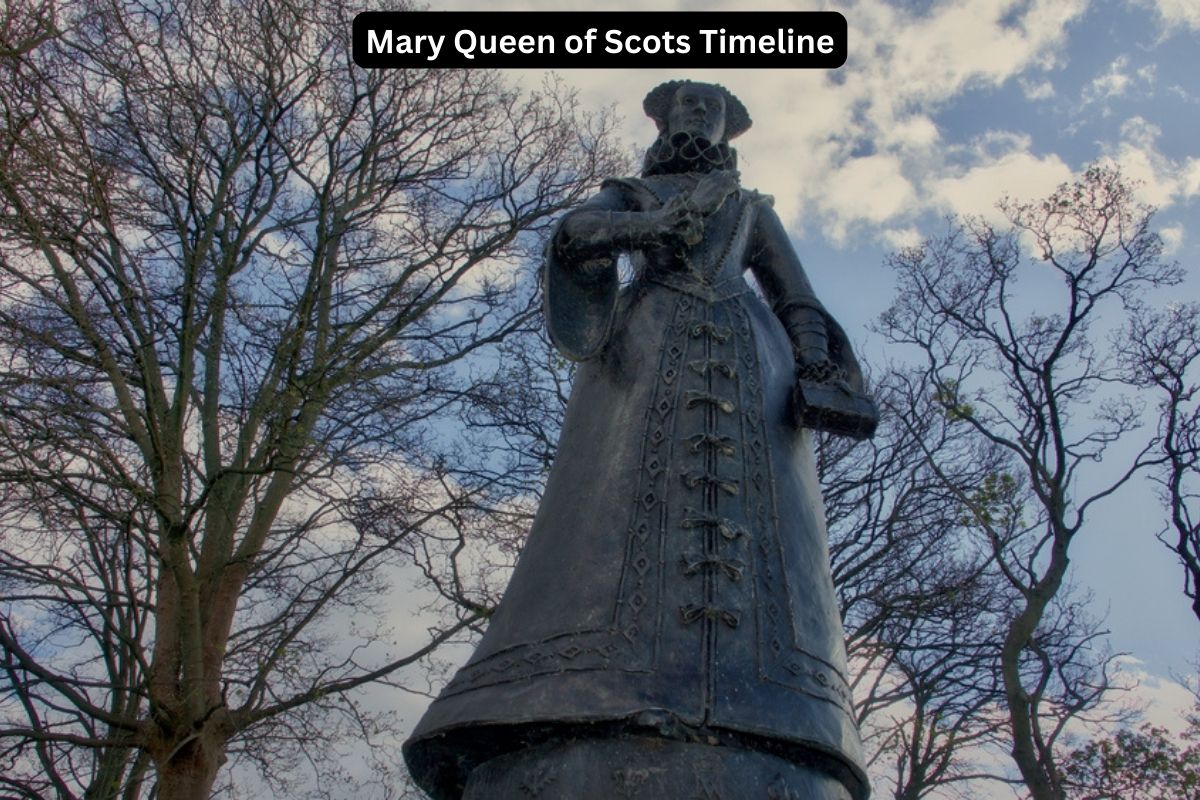Mary Stuart, Queen of Scots, born in 1542 in Linlithgow Palace, Scotland, ascended to the throne as an infant following her father’s death. After marrying the Dauphin of France in 1558 and his subsequent death in 1560, she returned to Scotland.
There, her tumultuous marriage to Lord Darnley, the birth of her son James, and her marriage to James Hepburn, Earl of Bothwell, fueled political unrest.
Defeated at the Battle of Langside in 1568, Mary sought refuge in England, only to face captivity for 19 years due to her claim to the English throne and her involvement in plots against Queen Elizabeth I.
In 1586, she was implicated in the Babington Plot, leading to her trial, conviction for treason, and execution by beheading on February 8, 1587, at Fotheringhay Castle in England. Her life is a complex and fascinating chapter in history.
| Year | Event |
|---|---|
| 1542 | Mary Stuart is born on December 8th in Linlithgow Palace, Scotland. |
| 1542 | Mary becomes Queen of Scotland at six days old after her father’s death. |
| 1548 | Mary is sent to France for her safety and upbringing, betrothed to Francis, the Dauphin of France. |
| 1558 | Mary marries Francis, becoming Queen Consort of France. |
| 1559 | Catherine de’ Medici becomes the regent of France following King Henry II’s death. |
| 1560 | The Treaty of Edinburgh is signed, ending hostilities between England and Scotland. Mary’s husband, Francis II, dies, and she returns to Scotland. |
| 1565 | Mary marries Lord Darnley to strengthen her claim to the English throne. |
| 1566 | Mary gives birth to her son, James, who later becomes King James VI of Scotland and King James I of England. |
| 1567 | Tensions in Mary’s marriage to Lord Darnley escalate, and he is murdered. Mary marries Bothwell and is forced to abdicate. |
| 1567 | Mary escapes Lochleven Castle but is defeated at the Battle of Langside. She flees to England. |
| 1568 | Mary is imprisoned in various English locations as a political prisoner by Queen Elizabeth I. |
| 1586 | Mary is implicated in the Babington Plot and put on trial for treason. |
| 1587 | Mary is found guilty of treason and executed by beheading at Fotheringhay Castle. |
| 1603 | Mary’s son, James VI of Scotland, becomes King James I of England after the death of Queen Elizabeth I. |
Timeline of Mary Queen of Scots
1542 – Born on December 8 in Linlithgow Palace, Scotland
Mary Stuart was born on December 8, 1542, at Linlithgow Palace in Scotland. Her birth was a momentous occasion as she was the daughter of James V of Scotland and Mary of Guise, making her the legitimate heir to the Scottish throne.

1542 – Becomes Queen of Scotland at just six days old
Tragically, Mary’s father, King James V, died just six days after her birth. As a result, the infant Mary became the Queen of Scotland. Given her tender age, a regency was established to govern on her behalf.
Also Read: Facts About Mary Queen of Scots
This marked the beginning of her royal journey, and her status as queen made her a central figure in the turbulent politics of the time.
1548 – Sent to France for safety, betrothed to Francis, the Dauphin of France
In 1548, due to the political instability in Scotland and the desire to strengthen the Franco-Scottish alliance, Mary was sent to France.
She was placed under the care of the French court and was betrothed to Francis, the Dauphin of France. This move ensured her safety and provided her with a royal upbringing in the French court.
1558 – Marries Francis, becoming Queen Consort of France
At the age of 15, in 1558, Mary married Francis, becoming the Queen Consort of France. This marriage not only solidified the alliance between Scotland and France but also thrust her into the intricate and sometimes treacherous world of European royal politics.
She played a role in the French court and developed a strong connection to France during this period.
1559 – Catherine de’ Medici becomes regent of France
In 1559, Catherine de’ Medici assumed the role of regent of France after the death of her husband, King Henry II, and the accession of her young son, Francis II, as king.
Also Read: Bloody Mary Facts
This was a crucial period for Mary as it meant that her mother-in-law, Catherine, held significant power in the French court. Mary was exposed to the intricate politics of the French court during Catherine’s regency.

1560 – Returns to Scotland after Francis’s death
Tragedy struck when Mary’s husband, Francis II, died in 1560, just over a year after their marriage. With the death of her husband, Mary lost her status as Queen Consort of France.
She decided to return to Scotland, where she took up the role of Queen of Scots. Her return marked a significant shift in her life as she faced the complex and often turbulent politics of her homeland.
1565 – Marries Lord Darnley
In 1565, Mary married Henry Stuart, Lord Darnley. This marriage was a strategic move aimed at strengthening her claim to the English throne through her Tudor ancestry.
However, the marriage was tumultuous and marked by power struggles and personal conflicts, ultimately leading to a breakdown in their relationship.
1566 – Gives birth to her son, James
In 1566, Mary gave birth to her son, James, who would later become James VI of Scotland and James I of England. James’s birth solidified Mary’s dynastic line and secured the Stuart succession. However, it did little to ease the tensions in her marriage to Lord Darnley.
1567 – Forced to abdicate, marries Bothwell
The year 1567 was a tumultuous one for Mary. Her marriage to Lord Darnley had become increasingly troubled, marked by infidelity and political intrigue.
In March of that year, a mysterious explosion occurred at Kirk o’ Field, and Lord Darnley was found dead. Though the details surrounding his death remain unclear, it was a turning point in Mary’s life.
Subsequently, Mary faced immense pressure and political turmoil. She married James Hepburn, Earl of Bothwell, who was widely suspected of being involved in Darnley’s murder. This controversial marriage further fueled opposition against her, leading to her eventual downfall.
1568 – Escapes to England after defeat at Langside
As opposition to her rule grew in Scotland, Mary faced a rebellion led by Protestant lords. In May 1568, the forces of Mary and the rebels clashed at the Battle of Langside. Mary’s forces were defeated, and she was forced to flee the battlefield.
Following her defeat at Langside, Mary sought refuge in England, hoping for support and protection from her cousin, Queen Elizabeth I of England. However, her arrival in England marked the beginning of a long period of captivity and uncertainty.
Instead of offering support, Queen Elizabeth I viewed Mary as a political threat due to her claim to the English throne as a Catholic and her potential involvement in plots against Elizabeth. As a result, Mary was kept in various English castles and manors as a political prisoner for nearly 19 years.
1586 – Implicated in the Babington Plot
In 1586, Mary was implicated in the Babington Plot, a Catholic conspiracy to assassinate Queen Elizabeth I. Letters were discovered that seemed to link Mary to the plot. These letters, which some historians believe might have been forgeries or manipulated, were used as evidence against her.
1587 – Found guilty of treason, executed on February 8
After being found guilty of treason in a trial, Mary, Queen of Scots, was sentenced to death. On February 8, 1587, she was executed by beheading at Fotheringhay Castle in England. Her execution marked the tragic end of a turbulent and complex life.
